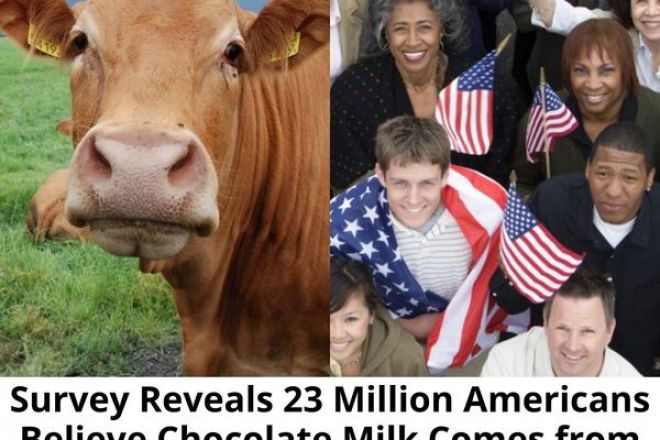A Deep Dive into the Chocolate Milk Survey The revelation that 23 million Americans believe chocolate milk comes from brown cows has perplexed many and prompted a thorough examination of the factors leading to such widespread misinformation.
The survey, conducted by the Innovation Center for U.S. Dairy, has sparked national conversations on the state of agricultural literacy in the United States. This article aims to break down the survey’s findings and explore the root causes of such misconceptions, while incorporating expert

### The Brown Cow Myth: Unpacking America’s Chocolate Milk Misconceptions
In a surprising revelation, a recent survey has found that approximately 23 million Americans are under the mistaken belief that chocolate milk comes from brown cows. The study, conducted by the Innovation Center of U.S. Dairy, highlights a significant gap in public understanding about the origins of this popular beverage.
### A Disturbing Discovery
The survey, which interviewed over 1,000 adults across the United States, uncovered that nearly one in seven respondents thought chocolate milk was produced directly from brown cows. This misconception has sparked widespread concern among dairy farmers and educators, who are now calling for increased educational efforts to clarify the process of milk production.
“Chocolate milk is simply regular milk mixed with chocolate; it does not come from a special breed of cow,” explained Dr. Susan Smith, a dairy education specialist. “It’s crucial for people to understand that all milk, whether it’s plain or flavored, comes from cows, regardless of their color.”
Factors Behind the Confusion

Chocolate milk, a favorite among both children and adults, is actually made by adding chocolate syrup or cocoa powder to regular milk. The survey revealed that the confusion may stem from a combination of factors, including misleading advertisements and a general lack of awareness about dairy production.
Experts suggest that the misconception might be reinforced by whimsical marketing tactics and imagery that inadvertently mislead consumers. For instance, advertisements showing brown cows in farms may unwittingly link the animals with chocolate milk in the minds of less-informed viewers.
### Educational Interventions
Experts are urging schools and community programs to include more comprehensive lessons about where milk comes from and how it is processed. Proactive educational strategies can help demystify dairy production.
“It’s essential to embed accurate agricultural education in school curriculums,” Dr. Smith added. Schools need to ensure that students gain a clear understanding of where their food comes from. City dwellers, in particular, may lack firsthand experience with farm life, further contributing to these misconceptions.
### Industry Response
The dairy industry is also stepping up its efforts to educate the public. Campaigns are being developed to dispel myths and provide clear information about milk production.
“We need to ensure that consumers have accurate knowledge about their food,” said Mike Johnson, a spokesperson for the Dairy Farmers of America. “This is an opportunity to enhance our educational outreach and improve public understanding.”
The Innovation Center of U.S. Dairy is planning a series of public service announcements and informational programs aimed at debunking myths. These initiatives will be shared via social media, schools, and community centers. By presenting simple, factual content, the dairy industry hopes to correct these misconceptions and foster a more informed public.
### Media’s Role in Shaping Perception
The media also has a pivotal role to play in either reinforcing or debunking food-related myths. While whimsical and creative advertising can captivate consumers, it is essential to strike a balance between engaging content and factual accuracy.
“Advertisers and marketers must be conscientious of the messages they send,” noted Julia Thompson, a consumer psychologist. “While creativity in marketing is important, conveying factual information about food products is equally crucial to avoid misleading consumers.”
### Collaborative Efforts
As the survey results continue to make waves, the dairy industry and educational institutions are working together to address these misconceptions and promote accurate information about milk and its production. Collaborative efforts between farmers, educators, media, and policymakers are essential to dispel such myths for good.
Public health experts also highlight the importance of accurate food education in promoting healthier dietary choices. Misinformation can lead to a range of problems, from poor dietary decisions to a lack of appreciation for the work that goes into food production.
### Final Thoughts
The misunderstanding regarding chocolate milk and brown cows underscores a broader issue about public knowledge related to food production. It reveals a stark disparity in understanding and emphasizes the need for better educational outreach.
By improving food education in schools, disseminating factual information through public campaigns, and encouraging responsible marketing practices, stakeholders can ensure that misconceptions like this become less common. Accurate, accessible, and engaging educational content can bridge the knowledge gap and help consumers make more informed choices about their food.
Through concerted efforts, the dairy industry, educators, and media can work together to nurture a more informed society, one that fully appreciates the journey from farm to table.





